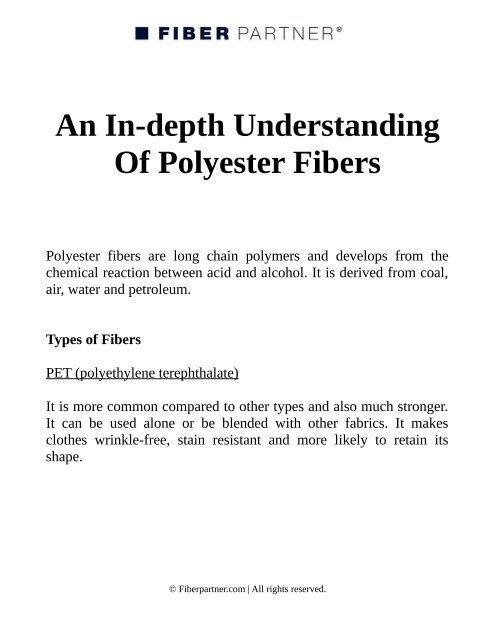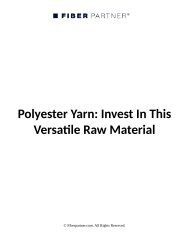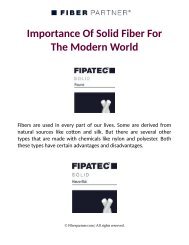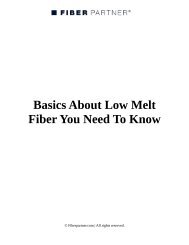An In-depth Understanding Of Polyester Fibers
Fiberpartner provides high tenacity polyester yarn for high performance applications. Get in touch now to know more.
Fiberpartner provides high tenacity polyester yarn for high performance applications. Get in touch now to know more.
Create successful ePaper yourself
Turn your PDF publications into a flip-book with our unique Google optimized e-Paper software.
<strong>An</strong> <strong>In</strong>-<strong>depth</strong> <strong>Understanding</strong><br />
<strong>Of</strong> <strong>Polyester</strong> <strong>Fibers</strong><br />
<strong>Polyester</strong> fibers are long chain polymers and develops from the<br />
chemical reaction between acid and alcohol. It is derived from coal,<br />
air, water and petroleum.<br />
Types of <strong>Fibers</strong><br />
PET (polyethylene terephthalate)<br />
It is more common compared to other types and also much stronger.<br />
It can be used alone or be blended with other fabrics. It makes<br />
clothes wrinkle-free, stain resistant and more likely to retain its<br />
shape.<br />
© Fiberpartner.com | All rights reserved.
PCDT (poly-1, 4-cyclohexylene-dimethylene terephthalate)<br />
More elastic and resilient, it is more suited for longer and heavier<br />
use like furniture covers and drapes.<br />
Manufacture<br />
<strong>Polyester</strong> is of 4 types - filament, staple, tow, and fiberfill. So<br />
manufacturing each type has some differences. While making<br />
filaments, each separate stand is kept intact, which results in<br />
continuous length and smooth fabrics. Filaments are short and in<br />
predetermined length in the staple form and thus easier to blend with<br />
other fibers. When the continuous filaments are loosely drawn<br />
together, then it becomes the Tow form. The last type is the Fiberfill,<br />
that is used to make quilts, pillows and outerwear and is voluminous.<br />
Among these 4, filament and staple are the more common ones.<br />
© Fiberpartner.com | All rights reserved.
Types of <strong>Polyester</strong> Yarns<br />
Filament Yarns<br />
This term refers to a long rope like bundle of raw fibers that has not<br />
been cut or processed into staple form. There are 2 varieties i.e.:<br />
monofilament and multifilament. If you wish to use fiber for sheer<br />
lightweight fabrics like tulle, voile and organdy, then you need<br />
regular tenacity polyester yarn that is bright for light, stretch and sag<br />
resistance. The semi dull version is used for certain apparels. A<br />
duller version is for shirts and trousers.<br />
© Fiberpartner.com | All rights reserved.
Textured Yarns<br />
These are processed to reduce transparency, slipperiness and<br />
formation of small tangles on the fiber. After texturing, the fabric<br />
becomes opaque, appears better and the texture, warmth and<br />
absorbency improves.<br />
Spun Yarns<br />
When a fiber and several types of fibers are twisted or "spun" to<br />
make a single thread. Combining natural fibers with synthetic fibers<br />
is common like cotton with polyester.<br />
For good quality polyester fiber yarn, you can get in touch with<br />
Fiber Partner. Visit our website fiberpartner.com or call +45 79 44<br />
77 22 today!<br />
© Fiberpartner.com | All rights reserved.






